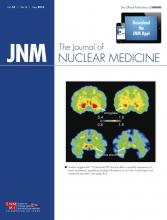M.J. Welch and W.C. Eckelman, Eds.
Boca Raton, FL: CRC Press, 2012, 370 pages, $179.95
Intended for an audience of clinicians, translational research scientists, molecular biologists, imaging scientists, pharmaceutical developers, physicists, fellows, and staffs, this book covers advances in molecular imaging in preclinical drug discovery, image-guided therapy, and target validation for differential diagnosis.
Information is provided on methods and development of biomarkers in biologic systems from bench to clinic. There are 19 chapters. The first 4 chapters discuss in vitro target validation and in vivo animal models for preclinical studies. Chapter 5 is an overview of proof of concept by radiopharmacology and the role of radiopharmacy in regulatory compliance for the clinic. The next 3 chapters are associated with nonnuclear probes such as optical, acoustic, and MR imaging nanomedicine. The remaining 11 chapters are focused on nuclear imaging probes for preclinical or translational work to clinical work in the central nervous system, heart, infection, hormones, and cancers. The topics include molecular imaging science in drug development, integration of molecular imaging and infection genomic and proteomic pathways, molecular imaging concept and target validation in probe development, development of cancer biomarkers for endpoint assessment, and image guidance of receptor-avid pathway-directed therapies. Clinic applications of the probes are also described in each chapter.
Other chapters in this book cover advances in molecular imaging—in both radioactive and nonradioactive applications—in preclinical drug discovery, drug development, drug delivery, pharmacokinetics and pharmacodynamics, and differential diagnosis. Four chapters focus on target validation and in vivo animal models for preclinical studies. The role of radiopharmacy and radiopharmacology is reviewed. Three chapters review the use of different nonradioactive imaging methods, including optical imaging, ultrasonography, and contrast-enhanced and diffusion-weighted MR imaging, to monitor and evaluate treatment response. Optical, acoustic, and MR imaging are proven valuable tools to provide important information facilitating individualized image-guided treatment and personalized management of diseases. These chapters also describe how changes in parameters measured early after initiation of a drug regimen can predict final treatment outcome. The trends in nuclear imaging involve image-guided pathway-directed therapies. Radiochemistry in PET and SPECT involves the use of coordination or covalent chemistry to incorporate radioisotopes. Chapters 9, 12, 14 and 15 describe the use of molecular imaging science in drug development. PET and SPECT agents provide cellular target information; thus, they can assess the effectiveness of treatment. Molecular imaging concept and target validation in probe development are described in chapters 11, 17, and 18. Chapters 16 and 19 describe the application of high-specific-activity receptor ligands for image guidance of receptor-avid pathway-directed therapies. Chapter 16 details the chemistry, biodistribution, dosimetry, and validation of an estrogen receptor imaging agent developed from bench to clinic. Chapter 10 describes the imaging of infection findings based on genomic expressions of thymidine kinase. Along with imaging and metabolomic validation, PET and SPECT agents may assist in the determination of optimal therapeutic dosing. Assessment of tumor cell proliferation can be helpful in the evaluation of tumor growth potential and the degree of malignancy and can provide an early assessment of treatment response before changes in tumor size can be determined by CT, MR imaging, or ultrasonography. The novel radiolabeled pyrimidine analogs may increase specificity in oncology applications and can influence diagnosis and the planning and monitoring of cancer treatment. Chapter 13 describes radiopharmaceuticals for imaging proliferation using pyrimidine analogs.
Greater understanding about molecular pathways, coupled with the development of radiolabeled biochemical compounds and devices to detect radioactivity by external imaging, has expanded the use of nuclear molecular imaging studies in drug development. PET and SPECT agents show high specific activities because they are made through a nuclear transformation and use carrier-free forms of isotopes. Chelators can coordinate radiometals for image-guided target assessment as well as patient selection, and the approach may be the cornerstone for theranostic applications. At present, PET and SPECT γ cameras are hybrids with CT or MR imaging to enhance their sensitivity to quantify drug properties in vivo in real-time dynamic events. PET/CT and SPECT/CT are better than PET and SPECT alone because multiple slices by CT and serial images by PET and SPECT provide better delineation of tumor volumes. In addition, PET/CT and SPECT/CT provide the capability to accurately evaluate posttherapy anatomic alteration. This book describes mainly PET and SPECT agent development, with less discussion on theranostic approaches in diseases, advances in hybrid imaging modalities for disease management, and challenges in regulatory compliance in biologic systems imaging. This book provides an important source of techniques used in radiochemistry and processing of radiopharmaceuticals developed from bench to clinic.
Footnotes
Published online Mar. 17, 2014.
- © 2014 by the Society of Nuclear Medicine and Molecular Imaging, Inc.







